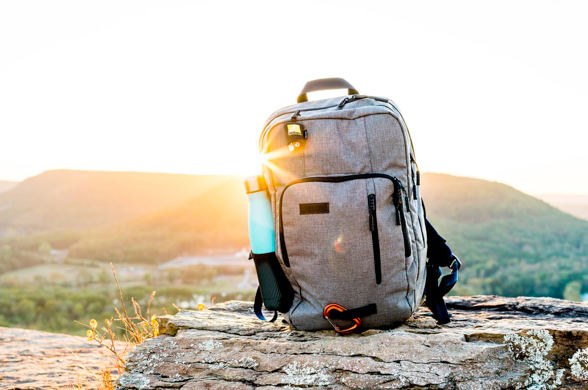Nothing beats spending a day outdoors surrounded by gorgeous landscapes and beautiful sceneries. One thing is for sure, if you are planning hiking a 13 kilometers trail, you are going to have to pack a few essentials. Carrying these essentials in a raggedy old backpack is probably not the best idea.
When you have to carry 10-20 kilograms worth of snacks, water, dry clothes, and survival tools you really have to consider getting a durable backpack. Not only one that can endure the harsh weather conditions but also one that won’t put extra strain on your back.
To help you choose the best outdoor backpack for your next adventure, we’ve conducted a buyer’s list of all the factors you have to consider before purchasing.
SIZE AND WEIGHT
The most important thing to consider is the bag’s size and weight. When it doesn’t have anything inside, how much does it weigh. You want to purchase a product that is lightweight but provides enough space for everything you want to take along.
One thing to know is that durability does compromise the overall weight of the bag. Using durable materials will add weight to the product. You can’t expect a thin fabric to be able to endure harsh terrains. Look for a product not heavier than 3 kilograms (6 pounds).
Tactical backpacks are a bit heavier than normal outdoor and hiking packs, only because they provide a lot of extra features while focusing on durability. Chances are, if you are looking around for a tactical backpack, that you are already trained in carrying a lot of weight. The extra bit of bag weight combined with the weight from essentials and equipment won’t be that hard to carry around.
Make sure that the size of the product fits your needs and that it fits comfortably onto your back.
For some excellent lightweight choices visit here: https://survivalmethods.net/best-tactical-backpacks/
CONSTRUCTION MATERIAL
Typical material used in tactical backpacks are thick and measured in denier. Regular backpacks have a denier rating of about 250, for tactical backpacks you have to look at a rating of at least 500. This will ensure that the bag is able to withstand abrasions, tears, and water.
Most durable bags will be made from materials such as polyester, Oxford cloth, or nylon. They are light in weight but also durable.
Another key thing to consider is whether the material has a water-resistant coating. It’s extremely important to pay a little bit extra for this coating, as a water-resistant product will be able to withstand heavy rain showers or trips down the river.
Look at other parts of the bag as well. Heavy-duty zippers and buckles, as well as strong Velcro or fastening straps, are parts that shouldn’t be neglected to look into.
COMPARTMENTS AND POCKETS
When walking in the wild you want your equipment to be easily accessible. Scavenging through one big pocket is no one’s idea of fun. As a rule, these backpacks should have two big main compartments in the middle of the bag. Then a variety of other smaller compartments and pockets either within the back or situated on the outside.
There should also be a few loops and straps which allow for the attachments of pocket knives, multi-tools, and torches. You can also hook your sunglasses in these or a buff. Don’t know what to pack? Check out this day hiking checklist for your next trip.
Consider the fabric that these compartments are made from too. The little side pockets can be made from a fleece-lined pocket, elastic and mesh, or even thermal linings. Some designs feature a space for a hydration pack, whilst others have the bladder hydration pack already installed. Depending on what your hydration needs are, you can consider either one.
As long as there are enough loops, pockets, compartments, and space for electronics, dry clothes, food, and other equipment, you’ll be able to increase the usability of the pack.
BACK SUPPORT
When the backpack isn’t designed to take as much strain from the shoulders and back as possible, then don’t even consider it. It’s extremely important for a heavy-duty backpack to provide as much support for your back as possible.
All the weight within the bag will press against your back and hang on your shoulders. Not only will it be extremely painful and uncomfortable, but it will create a lot of strain on your muscles.
It’s therefore important to consider a product that provides ample cushioning and padding on the back panels and shoulder straps. The padding should be breathable in order not to create a huge sweat patch on your back. Sweating through your back because the pack is directly laying on it, will dehydrate you much faster, which is something you don’t want.
Some back panels are made from mesh materials and even some soft plastic channels that allow air to pass through.
Consider a backpack that transfers some of the weight onto your hips. This is done by an extra strap that can be fastened around the waist and chest. The weight will be distributed across your body that will release strain from your upper back and create a much more comfortable walk.
FUNCTION AND USE
Tactical backpacks are designed and manufactured up to military standards. This means that they are able to endure all kinds of harsh terrains. This doesn’t mean that you can’t use them when you hike the best hiking trails in the world.
Consider whether you are going to use them as a daypack or as a tactical backpack that will be able to last you a few couple of days in the wilderness. Depending on what your use will be for it, will determine the size required to fulfill your needs.
As long as you consider the above-mentioned features combined with a decent thread count, waterproofing, durable water repellent, denier rating, storage space, and durability you’ll be able to find a high-quality tactical backpack for your next outdoor adventure.












{ 0 comments… add one }